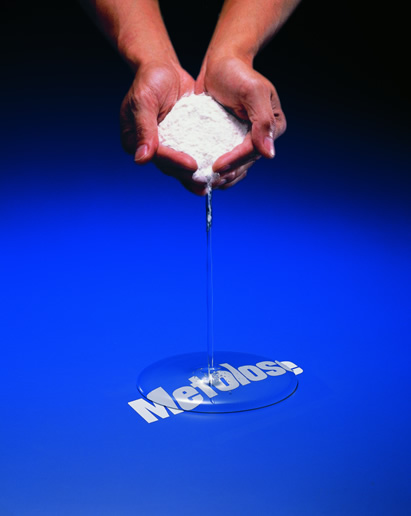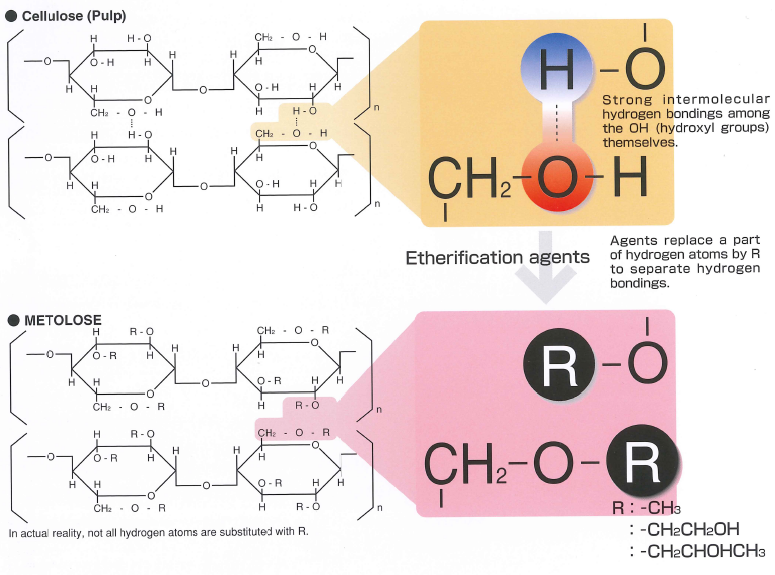METOLOSE®
What is METOLOSE®?

METOLOSE® is a nonionic water-soluble cellulose ether which is prepared from cellulose (pulp), a widely distributed natural material. The cellulose is treated with a caustic soda aqueous solution to produce an alkali cellulose which in turn is treated with etherification agents such as methyl chloride, propylene oxide or ethylene oxide yielding METOLOSE® . Although the cellulose contains many hydrophilic hydroxyl groups, it will not dissolve in water. This is because hydroxyl groups are creating strong intermolecular hydrogen bondings, thus forming crystal structures preventing water from flowing into the interval between cellulose molecules.
During the etherfication stage, some hydrogen atoms of the hydroxyl groups of cellulose are replaced by substituents such as methyl groups (-CH3), hydroxypropyl groups (-CH2CHOHCH3), or hydroxyethyl groups (-CH2CH2OH), and these substituents cancel the intermolecular hydrogen bondings to make METOLOSE® water-soluble.

Types of METOLOSE®
Types of METOLOSE® are divided as shown below according to the type of substituent groups introduced to the cellulose molecules as well as the degree of substitution and molar substitution
Typical degree of substitution and molar substitution for METOLOSE® products
| Type | SM | SH | SE | ||||
|---|---|---|---|---|---|---|---|
| 60SH | 65SH | 90SH | SEB | SNB | |||
| Chemical name | Methylcellulose (MC) |
Hydroxypropylmethyl cellulose (HPMC) |
Hydroxyethylmethyl cellulose (HEMC) |
||||
| Degree of substitution | Methoxy group (-OCH3) |
1.8 | 1.9 | 1.8 | 1.4 | 1.5 | 1.5 |
| Molar substitution | Hydroxypropoxy group (-OCH2CHOHCH3) |
- | 0.25 | 0.15 | 0.20 | - | - |
| Hydroxyethoxy group (-OCH2CH2OH) |
- | - | - | - | 0.20 | 0.30 | |
| CAS RN® | 9004-67-5 | 9004-65-3 | 9032-42-2 | ||||
* Degree of substitution
The average number of methoxy groups attached to the anhydroglucose unit of cellulose
* Molar substitution
The average number of moles of hydroxylpropoxy groups or hydroxylethoxy groups per mole of anhydroglucose unit of cellulose
(hi METOLOSE)
hi METOLOSE is METOLOSE® surface-treated with a little glyoxal. This product can rapidly turn wet and disperse without forming lumps even when added to cold water and then dissolve by continuing agitation. An addition of alkaline ingredients to the dispersion will speed up the dissolving process.
Grades of METOLOSE®
Major types of METOLOSE®
| Viscosity grades | SM | SH | SE | ||||
|---|---|---|---|---|---|---|---|
| SM,SH type | SE type | 60SH | 65SH | 90SH | SEB | SNB | |
| 03 | ○ | ||||||
| 04 | ○ | ||||||
| 06 | ○ | ||||||
| 15 | ○ | ○ | |||||
| 25 | ○ | ||||||
| 50 | ○ | ○ | |||||
| 100 | ○ | ○ | |||||
| 400 | ○ | ○ | ○ | ||||
| 1500 | ○ | ○ | |||||
| 4000 | 04T | ○ | ○ | ○ | ○ | ○ | |
| 8000 | ○ | ||||||
| 10000 | ○ | ||||||
| 15000 | 15T | ○ | ○ | ||||
| 30000 | 30T | ○ | ○ | ||||
| 60T | ○ | ||||||
| 100000 | ○ | ||||||
| Super high viscosity | ○(SHV-P) | ○(SHV-W) | |||||
Viscosity grade means viscosity (mPas or cPs) of 2wt.% aqueous solution at 20°C. In case of SE types, the number followed by a T should be multiplied by 1000. The above table shows major types of METOLOSE®. If you would like to have other types of METOLOSE®, please do not hesitate to contact us.
Major types of hi METOLOSE
| Viscosity grades | hiSH | |
|---|---|---|
| hi65SH | hi90SH | |
| 4000 | ○ | ○ |
| 15000 | ○ | |
| 30000 | ○ | |
| 100000 | ○ | |
The above table shows major types of hi METOLOSE. If you would like to have other types of hi METOLOSE, please do not hesitate to contact us.
Characteristics of METOLOSE®
- 1.Practically odorless and tasteless
- METOLOSE® is a fibrous or granular powder, white to slightly off-white in color, and practically odorless and tasteless.
- 2.Low ash content
- As METOLOSE® is a nonionic organic compound, it can be completely burned up under an appropriate burning condition. It also can be effectively purified by hot-water washing in the process of preparation, so its ash content is very low.
- 3.Solubility in cold water and thickening ability
- Although METOLOSE® is insoluble in hot water, it is soluble in cold water, forming a transparent viscous solution.
- 4.Thermal gelation
- An aqueous solution of METOLOSE® will precipitate or gel when heated to a certain temperature, but it reverts to the original solution state on subsequent cooling. The temperature at which gelation or precipitation occur depends on the type of METOLOSE®, its concentration and the rate of heating.
- 5.Resistance to salting out
- METOLOSE® is nonionic and it is not a polyelectrolyte. The aqueous solution of METOLOSE® is comparatively stable even in the presence of metal salts or organic electrolytes. However, when the concentration of electrolytes exceeds a certain limit, gelation and precipitation may result.
- 6.pH Stability
- The viscosity of an aqueous solution of METOLOSE® is hardly affected by acid or alkali, and the product can develop an original viscosity in the range of pH 3.0 - 11.0. However, the solution viscosity tends to decline during prolonged storage in an acid or alkaline condition.
- 7.Solubility in organic solvents
- Having comparatively hydrophobic methyl and hydroxypropyl groups, METOLOSE® is soluble in some organic solvents and also in water-organic solvent mixed solvents.
- 8.Surface activity
- An aqueous solution of METOLOSE® has a high surface activity and functions as a protective colloid agent, emulsion stabilizer, foam stabilizer, and dispersant.
- 9.Film forming
- METOLOSE® provides a strong, flexible and transparent film having a good barrier property against oil and grease.
- 10.Water retention
- Since METOLOSE® is hydrophilic and its aqueous solution is highly viscous, its addition to mortar, etc. provides the product with a high water retention.
- 11.Shape retention
- Since a highly concentrated aqueous solution of METOLOSE® shows a higher viscosity and visco-elasticity in comparison with other water-soluble polymers, it improves the shape retention of extruded ceramics and cement products.
- 12.Lubricity
- The addition of METOLOSE® decreases the frictional coefficient and improves the lubricity during extrusion process.
Field of application of METOLOSE® and compatible products
Field : Construction Industry Field
| Usage | Applicable types with METOLOSE® |
|---|---|
| Cement mortar | 90SH-4000, 15000, 30000 hi90SH-4000, 15000, 30000 SEB-04T |
| Cement-based base coat | 90SH-4000, 15000, 30000 |
| Tile setting mortar | 90SH-4000 hi90SH-4000 SEB-04T |
| Light-weight expanded sand mortar | 90SH-30000 hi90SH-15000, 30000 |
| Self-leveling compounds (cement-based or gypsum-based) | 90SH-4000, 30000 SNB-30T, 60T |
| Spray paint | hi90SH-4000, 15000, 30000 hi65SH-4000 |
| Fire protection covering | 90SH-15000 hi90SH-15000, 30000 |
| Lime plaster | 90SH-4000 |
| Gypsum -based adhesive and joint compound for gypsum board | hi90SH-4000, 30000 |
| Fiber reinforced cement | 90SH-4000, 30000 |
Field : Chemical Industry Field
| Usage | Applicable types with METOLOSE® |
|---|---|
| Thermal paper | SM-15, 25 60SH-03 |
| Ceramic extruded products | 60SH-4000 SM-4000 90SH-30000 65SH-4000 |
| Paint remover | 60SH-4000 65SH-4000 |
| Cosmetics | 60SH-4000, 10000 65SH-4000 |
| Suspension stabilizer for polymerization | 60SH-50 65SH-50 90SH-100 |
| Batteries | SM-400, 4000 65SH-400, 4000 |
| Latex emulsion products | SM-25 65SH-400, 1500, 4000 60SH-50 |
| Agricultural chemicals, Fertilizes | SM-15, 25 |
| Printing paste | SM-25 60SH-50 65SH-400 |
| Car shampoo | 60SH-4000, 10000 65SH-4000 |
| Aromatic agent | SM-100, 400, 1500, 4000, 8000 |
| Cat litter | 90SH-30000, 100000 SHV-P, PF SHV-W, WF |
